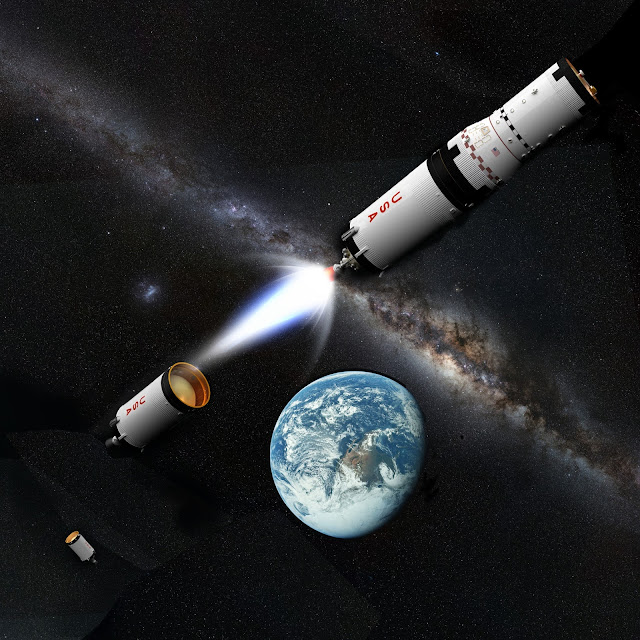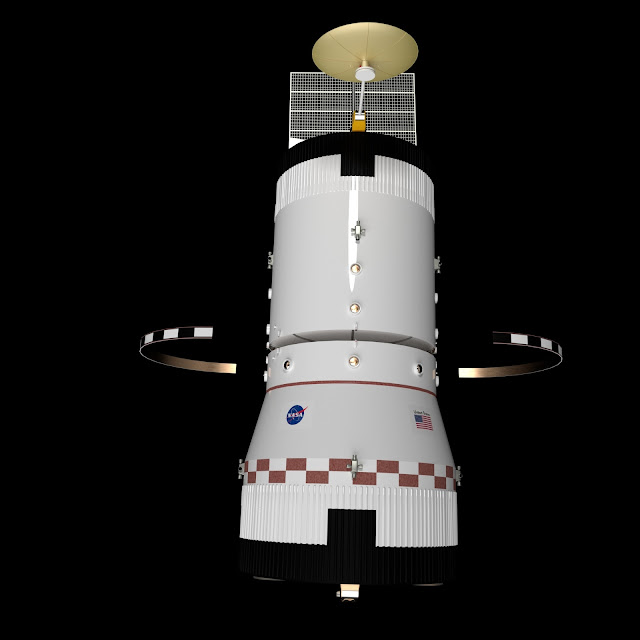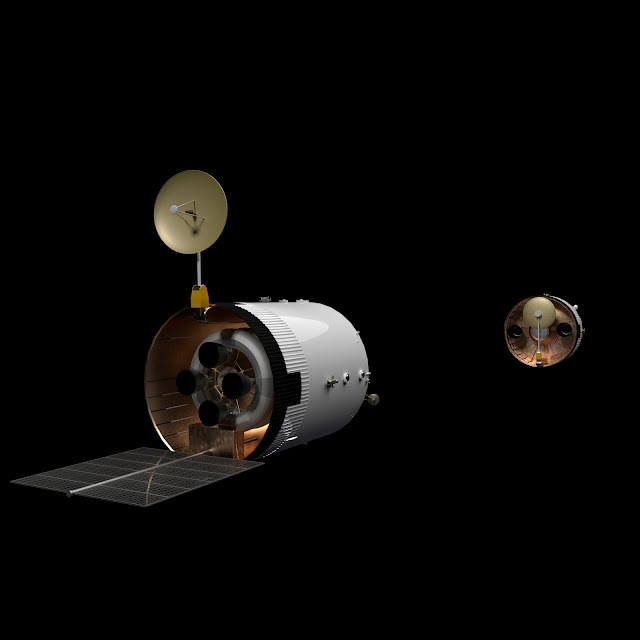A New Step in Spaceflight Evolution: To Mars by Flyby-Landing Excursion Mode (1966) (1)
27 September 2017 David S. F. Portree
 The images and captions that accompany this post are a "post-within-a-post." R. R. Titus, author of the study discussed in the main post text, provided few hints as to what his Flyby-Landing Excursion Mode (FLEM) spacecraft would look like, so these images are a plausible guess. They draw inspiration from many sources: the October 1966 NASA Planetary Joint Action Group piloted Mars flyby spacecraft design; Mariner 9, the first Mars orbiter (1971-1972); the Scientific Instrument Module (SIM) bays used to explore the moon from lunar orbit during Apollos 15, 16, and 17; Apollo Applications Program (AAP) Orbital Workshop concepts; and the informed imagination of their creator, artist William Black. In the image above, a spacecraft/booster "stack" assembled in Earth orbit from three modified Saturn S-IVB rocket stages and a two-part FLEM spacecraft (center right) completes final checks before leaving Earth.
The images and captions that accompany this post are a "post-within-a-post." R. R. Titus, author of the study discussed in the main post text, provided few hints as to what his Flyby-Landing Excursion Mode (FLEM) spacecraft would look like, so these images are a plausible guess. They draw inspiration from many sources: the October 1966 NASA Planetary Joint Action Group piloted Mars flyby spacecraft design; Mariner 9, the first Mars orbiter (1971-1972); the Scientific Instrument Module (SIM) bays used to explore the moon from lunar orbit during Apollos 15, 16, and 17; Apollo Applications Program (AAP) Orbital Workshop concepts; and the informed imagination of their creator, artist William Black. In the image above, a spacecraft/booster "stack" assembled in Earth orbit from three modified Saturn S-IVB rocket stages and a two-part FLEM spacecraft (center right) completes final checks before leaving Earth.  This fanciful rendition of FLEM mission Earth-orbit departure is a 21st-century artist's tribute to a very similar hand-painted NASA image of the 1960s. Earth-orbit departure would require perhaps two days, with S-IVB booster stage burns occurring at perigee (the low point in the spacecraft's elliptical orbit about the Earth). Because of this, the first and second S-IVB stages would not be in view when the third S-IVB ignited, as they are here, and the third S-IVB would not ignite so far from Earth. In this image, the last S-IVB stage fires its J-2 engine to place the FLEM spacecraft on course for Mars. After engine shutdown, the stage would detach and vent leftover propellants to nudge its course so that it would not follow the FLEM spacecraft and possibly collide with Mars.
This fanciful rendition of FLEM mission Earth-orbit departure is a 21st-century artist's tribute to a very similar hand-painted NASA image of the 1960s. Earth-orbit departure would require perhaps two days, with S-IVB booster stage burns occurring at perigee (the low point in the spacecraft's elliptical orbit about the Earth). Because of this, the first and second S-IVB stages would not be in view when the third S-IVB ignited, as they are here, and the third S-IVB would not ignite so far from Earth. In this image, the last S-IVB stage fires its J-2 engine to place the FLEM spacecraft on course for Mars. After engine shutdown, the stage would detach and vent leftover propellants to nudge its course so that it would not follow the FLEM spacecraft and possibly collide with Mars.During its first dozen years, NASA piloted spaceflight followed an evolutionary course, with simple missions and spacecraft leading to more complex and capable ones. Single-man Mercury suborbital missions led to Mercury orbital missions of increasing duration; then, in 1965-1966, two-man Gemini missions progressively added maneuverability, the ability to rendezvous and dock, spacewalk capability, and flight durations of up to 14 days.
Next came Apollo. NASA conducted four piloted preparatory missions in 1968-1969 ahead of the first lunar landing attempt. Apollo 7 (October 1968), launched on a two-stage Saturn IB rocket, tested the Command and Service Module (CSM) in Earth orbit. The CSM comprised a drum-shaped Service Module (SM) and the conical Command Module (CM) bearing its three-man crew.
As in biological evolution, contingency played a role in spaceflight evolution: for example, Apollo 8, intended originally as a Saturn V rocket-launched high-Earth-orbit test of the CSM and the bug-like Lunar Module (LM) moon lander, became a CSM-only lunar-orbital mission after the LM was delayed and the Soviet Union appeared close to launching a cosmonaut around the moon.
The Apollo 8 astronauts reached lunar orbit on Christmas Eve 1968. In addition to forestalling Soviet attempts to upstage the first Apollo lunar landing mission, Apollo 8's 10 lunar orbits tested upgrades made to the Manned Space Flight Network, NASA's world-wide radio communications and tracking system, and gave console operators in Mission Control early experience in supporting a piloted lunar mission. The Apollo 8 CSM left lunar orbit on Christmas Day 1968, and splashed down in the Pacific Ocean on 27 December 1968.
Apollo 9 (March 1969) saw the first Earth-orbital test of the LM and CSM together. Apollo 10 (May 1969) was a dress-rehearsal in low-lunar orbit for Apollo 11 (July 1969), the first piloted lunar landing.
Apollo 11 is perhaps best understood as an engineering mission; it was a cautious end-to-end test of the Apollo system with a single two-and-a-half-hour moonwalk and only limited science objectives. Apollo 12 (November 1969) demonstrated the pin-point landing capability required for pre-mission geologic traverse planning by setting down near a known point on the moon: specifically, the Surveyor III automated soft-lander, which had landed in April 1967. It also saw a pair of moonwalks lasting nearly four hours each and deployment of the first Apollo Lunar Scientific Experiment Package (ALSEP).
Apollo 13 (April 1970), the first science-focused mission, suffered a crippling explosion midway to the moon, scrubbing its lunar landing, but its crew's safe return to Earth demonstrated the Apollo system's maturity and the Apollo team's experience. Apollo 14 (January-February 1971) included two moonwalks, each lasting more than four-and-a-half hours. They included a strenuous 1.3-kilometer trek through the hummocky ejecta blanket surrounding 300-meter-wide Cone Crater, a natural drill hole in the scientifically important Fra Mauro Formation.
Apollo 15 (July-August 1971), Apollo 16 (April 1972), and Apollo 17 (December 1972), designated "J" missions, featured a host of evolutionary improvements. Beefed-up LMs permitted surface stay times of up to three days at complex and challenging landing sites, heavier returned lunar samples, and more complex ALSEPs. Space suit improvements and Boeing's Lunar Roving Vehicle enabled geologic traverses ranging over kilometers of the lunar surface. Each "J" mission CSM included a suite of sensors which its pilot could turn toward the moon. Apollo 15 visited the Hadley Rille/Apennine Mountains area; Apollo 16 the central Nearside Lunar Highlands; and Apollo 17, Taurus-Littrow, on the edge of Mare Serenitatis.
 Conceptual FLEM spacecraft. A black-and-white band about halfway along its length marks where it will separate into two parts as it nears Mars. To the left of the band is the Mars Orbiter (R. R. Titus called it the "excursion module") and to the right is the Flyby Spacecraft (Titus dubbed it the "parent" spacecraft). The Orbiter mission module has a single deck with living space for a two-person crew - portholes for viewing Mars occur 45 degrees apart around its circumference - while the Flyby Spacecraft has two decks that provide living space for the entire four-person FLEM mission crew. While linked, the spacecraft rely on a solar array and a radio dish extended from the aft end of the Flyby Spacecraft for electrical power and communication with Earth.
Conceptual FLEM spacecraft. A black-and-white band about halfway along its length marks where it will separate into two parts as it nears Mars. To the left of the band is the Mars Orbiter (R. R. Titus called it the "excursion module") and to the right is the Flyby Spacecraft (Titus dubbed it the "parent" spacecraft). The Orbiter mission module has a single deck with living space for a two-person crew - portholes for viewing Mars occur 45 degrees apart around its circumference - while the Flyby Spacecraft has two decks that provide living space for the entire four-person FLEM mission crew. While linked, the spacecraft rely on a solar array and a radio dish extended from the aft end of the Flyby Spacecraft for electrical power and communication with Earth.As early as 1962, engineers foresaw two evolutionary paths for Saturn rockets and Apollo spacecraft hardware after they accomplished President John F. Kennedy's goal of a man on the moon by 1970. The engineers were guided by President Lyndon Baines Johnson's 1964 decision that, to contain cost, NASA's piloted space program after the moon landing should be based on hardware developed for Apollo. This marked the advent of the Apollo Applications Program (AAP).
One path would see moon missions continue more or less indefinitely, growing ever more capable and culminating in a permanent lunar base in the 1980s. Alternately, NASA might repurpose Apollo hardware to build, launch, and maintain an evolutionary series of space stations in Earth orbit.
The space station path appeared pedestrian compared to the lunar base path, yet it offered great potential for long-term future exploration. This was because it promised to prepare astronauts and spacecraft for long-duration missions in interplanetary space. In 1965-1966, NASA advance planners envisioned a series of Earth-orbiting space workshops based on the Apollo LM and the Saturn IB rocket S-IVB stage. Apollo CSMs would ferry up to six astronauts at a time to the workshops for progressively longer stays.
Some planners thought that NASA should jump straight from the early space workshops to piloted Mars landing missions using nuclear-thermal propulsion, but others called for a conservative continuation of the evolutionary approach. If the latter had won the day, the mid-1970s might have seen a new-design space station climb to Earth orbit atop an improved Saturn V rocket. Derived from Apollo hardware and new technology tested on board the orbiting workshops, the station would in fact have constituted a prototype interplanetary Mission Module. A crew might have lived on board without resupply or visitors for almost two years to help prepare NASA for its first piloted Mars voyage.
In keeping with the evolutionary approach, the first piloted voyage beyond the moon might have been a Mars flyby with no piloted Mars landing. The piloted Mars flyby spacecraft, which would have carried a cargo of robotic Mars probes, would have been built around the Mission Module tested in Earth orbit. The mission might have commenced as early as late 1975, when an opportunity to launch a minimum-energy Mars flyby was due to occur.
As they raced past Mars in early 1976, the four flyby astronauts would have released automated probes and turned a suite of sensors mounted on their spacecraft toward Mars and its irregularly shaped moons Phobos and Deimos. They would have reached their greatest distance from the Sun in the Asteroid Belt, so asteroid encounters would have been a possibility. As their Sun-centered elliptical orbit brought them back to Earth's vicinity in 1977, they would have separated in an Apollo CM-derived Earth-return capsule and reentered Earth's atmosphere.
In addition to observing Mars close up, the astronauts would have continued the effort, begun in earnest during Gemini flights and continued on board the Earth-orbiting workshops and prototype interplanetary Mission Module, to determine whether extended piloted missions were medically feasible. The flyby crew might have found, for example, that artificial gravity is a must during years-long interplanetary voyages. Their results would have shaped the next interplanetary mission, which might have taken the form of a piloted Mars orbiter in the spirit of Apollo 8 and Apollo 10, or, if the space agency felt sufficiently confident in its abilities, a Mars orbital mission with a short piloted excursion to the martian surface in the spirit of Apollo 11.
 Sixty days from Mars: two of the FLEM mission's four astronauts transfer to the Orbiter. After an exhaustive systems check, they fire explosive bolts to cast off the two-part "spacer" linking their spacecraft and the drum-shaped Flyby Spacecraft. A docking mechanism retracts, then small thrusters push the two spacecraft apart.
Sixty days from Mars: two of the FLEM mission's four astronauts transfer to the Orbiter. After an exhaustive systems check, they fire explosive bolts to cast off the two-part "spacer" linking their spacecraft and the drum-shaped Flyby Spacecraft. A docking mechanism retracts, then small thrusters push the two spacecraft apart.  The Orbiter slowly backs away from the Flyby Spacecraft as its two-person crew carries out one last check of critical systems. The two astronauts on the Flyby Spacecraft, meanwhile, inspect the Orbiter's hull. This image shows the Flyby Spacecraft's propulsion system (left), which will be used near Mars to carry out Titus's "powered flyby" maneuver. Donut-shaped propellant tanks surround a conical Apollo Command Module (CM)-derived Earth Reentry Module (ERM); their structure and the propellants they contain provide added radiation shielding to the ERM, which serves double-duty as the Flyby Spacecraft solar storm shelter.
The Orbiter slowly backs away from the Flyby Spacecraft as its two-person crew carries out one last check of critical systems. The two astronauts on the Flyby Spacecraft, meanwhile, inspect the Orbiter's hull. This image shows the Flyby Spacecraft's propulsion system (left), which will be used near Mars to carry out Titus's "powered flyby" maneuver. Donut-shaped propellant tanks surround a conical Apollo Command Module (CM)-derived Earth Reentry Module (ERM); their structure and the propellants they contain provide added radiation shielding to the ERM, which serves double-duty as the Flyby Spacecraft solar storm shelter. Using its Apollo-type thruster quads, the Orbiter turns away from the Flyby Spacecraft, positioning itself for the separation burn, the maneuver that will enable it to reach Mars 16 days ahead of the Flyby Spacecraft. The Orbiter and Flyby Spacecraft main engine designs would be based on Apollo spacecraft engines; in this illustration, all six are assumed to be derived from the Lunar Module descent engine.
Using its Apollo-type thruster quads, the Orbiter turns away from the Flyby Spacecraft, positioning itself for the separation burn, the maneuver that will enable it to reach Mars 16 days ahead of the Flyby Spacecraft. The Orbiter and Flyby Spacecraft main engine designs would be based on Apollo spacecraft engines; in this illustration, all six are assumed to be derived from the Lunar Module descent engine.In January 1966, United Aircraft Research Laboratories engineer R. R. Titus unveiled a proposal for a new intermediate step in spaceflight evolution. He dubbed it FLEM, which stood for "Flyby-Landing Excursion Mode." FLEM missions would, Titus wrote, have a natural place in the evolutionary sequence between piloted Mars flybys and piloted Mars orbiters. A FLEM mission might even have become the basis for an early, very brief, piloted Mars landing.
Titus explained that, in the "standard stopover mode," which encompassed Mars orbital and landing missions, all major maneuvers would involve the entire Mars spacecraft. This meant that the Mars spacecraft would need a large mass of propellants, which in turn meant that many expensive heavy-lift rockets would be required to launch the spacecraft, its propellants, and its Earth-orbit departure stages into Earth orbit for assembly.
Propellant mass required would vary greatly from one Earth-Mars transfer opportunity to the next over a roughly 15-year cycle because Mars has a decidedly elliptical orbit. Because of this, the Mars spacecraft and the sequence of launches needed to boost its components and propellants into Earth orbit would have to be redesigned for each standard stopover mode Mars mission.
The United Aircraft engineer added that errors or malfunctions during standard stopover mode "high-risk" Mars capture and escape maneuvers could result in "complete mission failure" because the entire spacecraft would be involved. Because the Mars spacecraft would be very massive already, it would be difficult and costly to include extra propellants that would enable a mission abort that could save the crew.
He noted that required propellant mass might be reduced and made to vary less over multiple Earth-Mars transfer opportunities if the spacecraft skimmed through Mars's upper atmosphere to slow down and capture into Mars orbit (that is, if it performed aerocapture). If, however, artificial gravity were found to be necessary for crew health, then stowing a spinning artificial-gravity system of sufficient radius behind an aerocapture heat shield would probably prove infeasible. The mission would then have to rely entirely on propulsive braking.
Titus explained that his FLEM concept, in addition to forming a natural evolutionary extension of piloted Mars flybys, would address many inherent problems of the standard stopover mode. One part of the FLEM spacecraft, the "parent" spacecraft, would not capture into Mars orbit. It could include a spinning artificial-gravity system. The other part, the "excursion module," would capture into Mars orbit using chemical rockets or, perhaps, by skimming through the martian atmosphere behind an aerocapture heat shield.